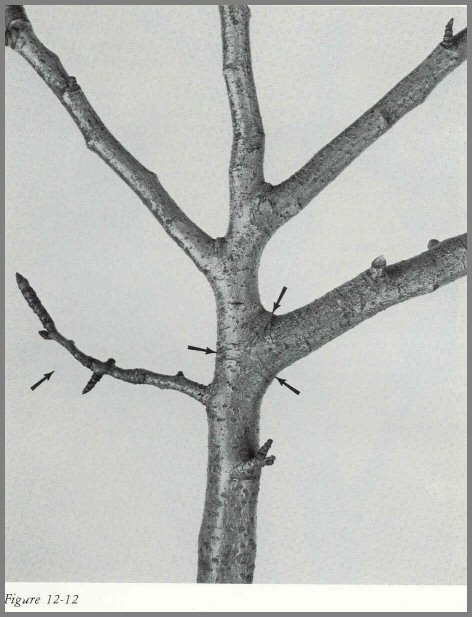 What
are often called branches are really not branches but codominant stems.
The pear, Pyrus communis, sample in figure 12 has many codominant stems but only
one branch (arrow, left). Each codominant stem is connected to 50% of the
trunk below it. The tissue arrangements are also different from branches.
Because each codominant stem has equal rank, there is no branch collar or trunk
collar. A bark ridge does form where the stems come together (upper arrow
in crotch). A raised bark ridge forms where the first circle of raised
bark formed. The lower arrows show the lower bark ridges. When a
codominant stem is removed, the cuts should go from the right side of the upper
arrow to the lower arrow at right for the removal of the right stem. For
the removal of the left stem, start at the left side of the upper arrow and cut
to the point of the lower arrow at left. The stem bark ridge in the crotch
is the key to proper pruning of codominant stems. The bottom raised
bark ridges show where the cuts should end.
What
are often called branches are really not branches but codominant stems.
The pear, Pyrus communis, sample in figure 12 has many codominant stems but only
one branch (arrow, left). Each codominant stem is connected to 50% of the
trunk below it. The tissue arrangements are also different from branches.
Because each codominant stem has equal rank, there is no branch collar or trunk
collar. A bark ridge does form where the stems come together (upper arrow
in crotch). A raised bark ridge forms where the first circle of raised
bark formed. The lower arrows show the lower bark ridges. When a
codominant stem is removed, the cuts should go from the right side of the upper
arrow to the lower arrow at right for the removal of the right stem. For
the removal of the left stem, start at the left side of the upper arrow and cut
to the point of the lower arrow at left. The stem bark ridge in the crotch
is the key to proper pruning of codominant stems. The bottom raised
bark ridges show where the cuts should end. Branches have built in protection zones at their base, but codominant stems do not have such zones because they are really extensions of the stem. The problem that comes with a tree with many codominant stems is that any pathogen can spread downward, or upward, with little natural resistance. These points are very important for fire blight - Erwinia amylovora - and Dutch elm disease - Ceratocystis ulmi. Once these pathogens infect codominant stems, they can spread rapidly. Some varieties of pear have many codominant stems and few branches. These trees are killed rapidly when infected by E, amylovora. The same can be said with elms that have the vase-shape form that is made up of many codominant stems.
Once a tree begins forming codominant stems, its crown will begin to form. In the forest this could be the beginning of the end for young trees that require high amounts of sunlight. Once a tree does grow to the height of the canopy and codominant stems begin to form, further height growth is greatly diminished. The "tree" that forms from the codominant stem reiterates the form of the entire tree. The multiple tree, or tree 2, becomes fully developed when many codominant stems form.
Early pruning could either reduce or enhance the formation of codominant stems. In this way the height of the tree could be controlled. But, you can not come back after a tree is mature and try to do this. Early pruning is the best way to assure tree health, size, and safety.
Page 225 A NEW TREE BIOLOGY. Read the book for more. Also see MODERN ARBORICULTURE and the WORLD WIDE PRUNING GUIDE